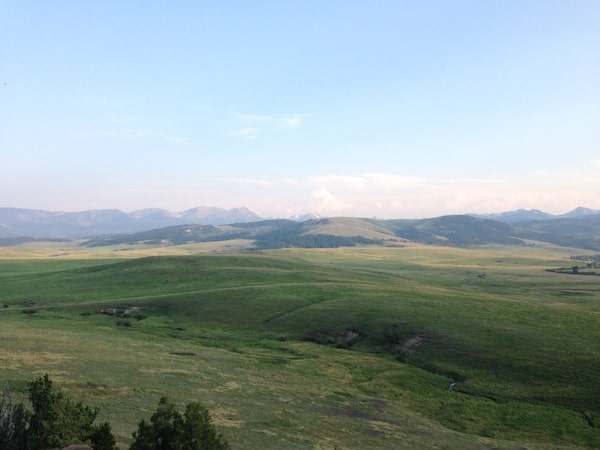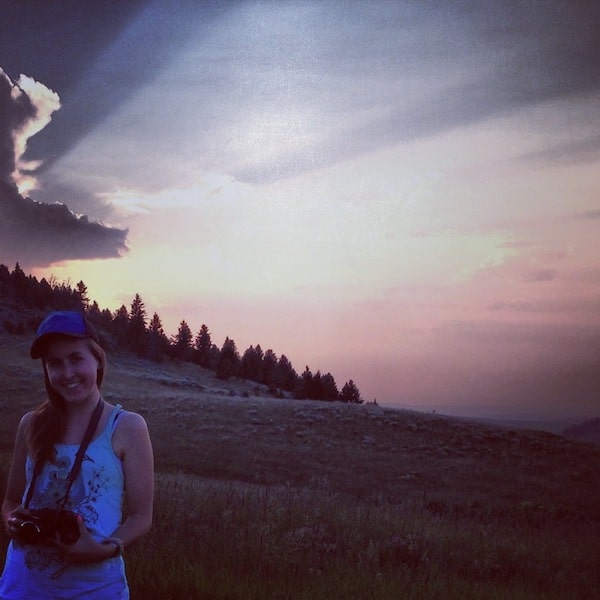The past couple days at the Flying D ranch were at once surreal and terrifically exciting. We left U of M and drove down to the Flying D ranch, one of Ted Turner’s 15 Western U.S. Ranches (makes my small Queens apartment seem absurd). This ranch and his others are special in that they’re designated as what (Montana State Senator) Mike Phillips calls a ‘wild working landscape.’ In other words, the bison ranching done on his ranch as well as its other activities like research on Trout in the Cherry Creek drainage are to be conducted in accordance with their mission, which aims: “to manage Turner lands in an economically sustainable and ecologically sensitive manner while promoting the conservation of native species.” This philosophy allows natural processes to take precedence, but still recognizes the “hand of man.” That aside, everyone involved with the ranch recognizes that Ted Turner is first and foremost a businessman, and a wealthy one at that. It will be interesting to read the most recent book about him by Todd Wilkinson, of which we all got free copies.

The ranch itself is near Yellowstone National Park, and you can actually see the snow-capped mountains of YNP from some of the higher areas where we were wandering through. Our group stayed at Cow Camp, and we dropped all of our stuff off quickly so we could get back out in the fields and look at the bison roaming around in the late afternoon sun. There are about 5,000 bison on this particular ranch, and the calves will be sent off for slaughter (sorry vegans) next year to be consumed at one of Ted’s Montana Grill restaurants around the country. If you’re confused about Turner, conservation, hunting, and bison ranching all being intertwined and connected, don’t worry, you’re not alone. The notion that a private ranch can also be seen as an ideal setting for conservation easements, strategic development sensitive to the migratory and predatory activities of local carnivores, and a refuge for endangered flora and fauna is an obvious paradox. Yet at the same time, I am also inclined to acknowledge Ted Turner and his team for their vision. They are a ranch that is situated amongst a hostile environment of neighbors that would very much like to see Flying D’s Bear Trap wolf pack (and all the other wolf packs) eliminated from the area. For the ranch to be willing (to an extent) to allow wolves to predate naturally on this private landscape is commendable. Still, I recognize that some readers may disagree fundamentally with this vision, so I leave you to make up your own mind.

There are 5,000+ bison on this ranch, and I’m pretty sure I managed to take more than that many pictures of each of them.
On a less politically charged note, my friend and I have an ongoing back and forth tradition where we attempt to document and swap pictures of ‘casually beautiful things.’ I’m convinced that my photos this week have put me in the lead (as you’ll see below). At Cow Camp, we spent a few minutes adding layers to gear up for the rapid temperature change that occurs when the sun goes down in the West Yellowstone area, and we trudged through the field of bison to go look for the Bear Trap wolf pack. Our fearless leader Mike, who had been kind enough to tell us way more than we could have imagined about the ranch, the area’s history, and the creatures roaming the 100,000+ acres, decided he would take us to a bear den. The den, of course, did not have any bears in it. However, it had been used as recently as this past winter by a black bear. Even bears have to escape the dreaded polar vortex somehow. Naturally, I did as any sane person would do; I followed Mike down the rocky and steep cliff and then proceeded to crawl on my belly into the narrow cave space. I must say, I was impressed by the bear’s choice. Lot’s of tunnel space, a nice rattlesnake skin lining the walls (for art I presume), and some sage brush dragged in for decor (I’m still sneezing from inhaling it all). I had to shimmy my way out butt first and be careful not to keep on shimmying right over the edge of the cliff. It gave me new respect for those big critters’ ability to navigate treacherous spaces.

I’m squinting because the Sage Brush made my allergies seize up, crawling in that bear cave and seeing the view after was well worth it. That’s Cow Camp behind me, and further back is YNP.
After the bear cave, we toted our sack dinners and parked ourselves on a cliff overlooking the area where the bison were wandering off to find a place to sleep. That area also happened to be where the radio telemetry indicated the Bear Trap pack was hanging out. We had Mike do his best wolf howl to see if we could get their attention. Honestly, I was really too excited to eat. By this point, I had already caused my eyes to swell shut from crawling around in every known allergen in the state of Montana and had gotten to meet some amazingly interesting people (and animals). The very idea of seeing wolves, one of my favorite animals (don’t tell anyone!), made me practically shake with excitement. We sat for a long time as the sun set, listening and looking through our binoculars for them. We didn’t hear anything, so we started to pack up. Then, right as we were leaving, we started to hear this low rolling cry from the hill across from ours. I’m convinced that the black shadow I saw dart through the trees was one of the wolves returning our call. Mike reassured me that I wasn’t imagining things because the Alpha male of the pack is black. Regardless, their long rolling howls were unmistakeable. We sat for about ten minutes, and we just simply listened until the pack tired themselves out and stopped. After, we all walked back, slightly more mesmerized than before, and chatted with one another about the days events over the spitting campfire and toasted marshmallows. Michael Soule delivered an excellent talk, and I drifted off to my cabin, stumbling the whole way because I kept looking up at the stars in the sky that I so rarely get to see back in NYC.

Waiting for the Bear Trap pack to respond to us.

Happy camper

Casually beautiful setting (D.R.E. this one’s for you!)

Crackling fire and a clear night in Big Sky Country.